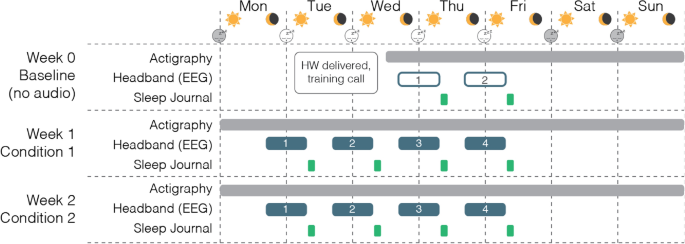2024-09-25 マサチューセッツ工科大学(MIT)
<関連情報>
- https://news.mit.edu/2024/startup-elemind-helps-people-fall-asleep-0925
- https://www.nature.com/articles/s41598-024-63385-1
- https://www.nature.com/articles/s41467-020-20581-7
入眠時不眠症の症状を治療するためのアルファ位相同期聴覚刺激の無作為化比較試験 A randomized controlled trial of alpha phase-locked auditory stimulation to treat symptoms of sleep onset insomnia
Scott Bressler,Ryan Neely,Ryan M Yost & David Wang
Scientific Reports Published:06 June 2024
DOI:https://doi.org/10.1038/s41598-024-63385-1
An Author Correction to this article was published on 19 September 2024

Abstract
Sleep onset insomnia is a pervasive problem that contributes significantly to the poor health outcomes associated with insufficient sleep. Auditory stimuli phase-locked to slow-wave sleep oscillations have been shown to augment deep sleep, but it is unknown whether a similar approach can be used to accelerate sleep onset. The present randomized controlled crossover trial enrolled adults with objectively verified sleep onset latencies (SOLs) greater than 30 min to test the effect of auditory stimuli delivered at specific phases of participants’ alpha oscillations prior to sleep onset. During the intervention week, participants wore an electroencephalogram (EEG)-enabled headband that delivered acoustic pulses timed to arrive anti-phase with alpha for 30 min (Stimulation). During the Sham week, the headband silently recorded EEG. The primary outcome was SOL determined by blinded scoring of EEG records. For the 21 subjects included in the analyses, stimulation had a significant effect on SOL according to a linear mixed effects model (p = 0.0019), and weekly average SOL decreased by 10.5 ± 15.9 min (29.3 ± 44.4%). These data suggest that phase-locked acoustic stimulation can be a viable alternative to pharmaceuticals to accelerate sleep onset in individuals with prolonged sleep onset latencies. Trial Registration: This trial was first registered on clinicaltrials.gov on 24/02/2023 under the name Sounds Locked to ElectroEncephalogram Phase For the Acceleration of Sleep Onset Time (SLEEPFAST), and assigned registry number NCT05743114.
時間的コヒーレンスの位相同期破壊による本態性振戦の非侵襲的抑制 Non-invasive suppression of essential tremor via phase-locked disruption of its temporal coherence
Sebastian R. Schreglmann,David Wang,Robert L. Peach,Junheng Li,Xu Zhang,Anna Latorre,Edward Rhodes,Emanuele Panella,Antonino M. Cassara,Edward S. Boyden,Mauricio Barahona,Sabato Santaniello,John Rothwell,Kailash P. Bhatia &Nir Grossman
Nature Communications Published:13 January 2021
DOI:https://doi.org/10.1038/s41467-020-20581-7

Abstract
Aberrant neural oscillations hallmark numerous brain disorders. Here, we first report a method to track the phase of neural oscillations in real-time via endpoint-corrected Hilbert transform (ecHT) that mitigates the characteristic Gibbs distortion. We then used ecHT to show that the aberrant neural oscillation that hallmarks essential tremor (ET) syndrome, the most common adult movement disorder, can be transiently suppressed via transcranial electrical stimulation of the cerebellum phase-locked to the tremor. The tremor suppression is sustained shortly after the end of the stimulation and can be phenomenologically predicted. Finally, we use feature-based statistical-learning and neurophysiological-modelling to show that the suppression of ET is mechanistically attributed to a disruption of the temporal coherence of the aberrant oscillations in the olivocerebellar loop, thus establishing its causal role. The suppression of aberrant neural oscillation via phase-locked driven disruption of temporal coherence may in the future represent a powerful neuromodulatory strategy to treat brain disorders.


